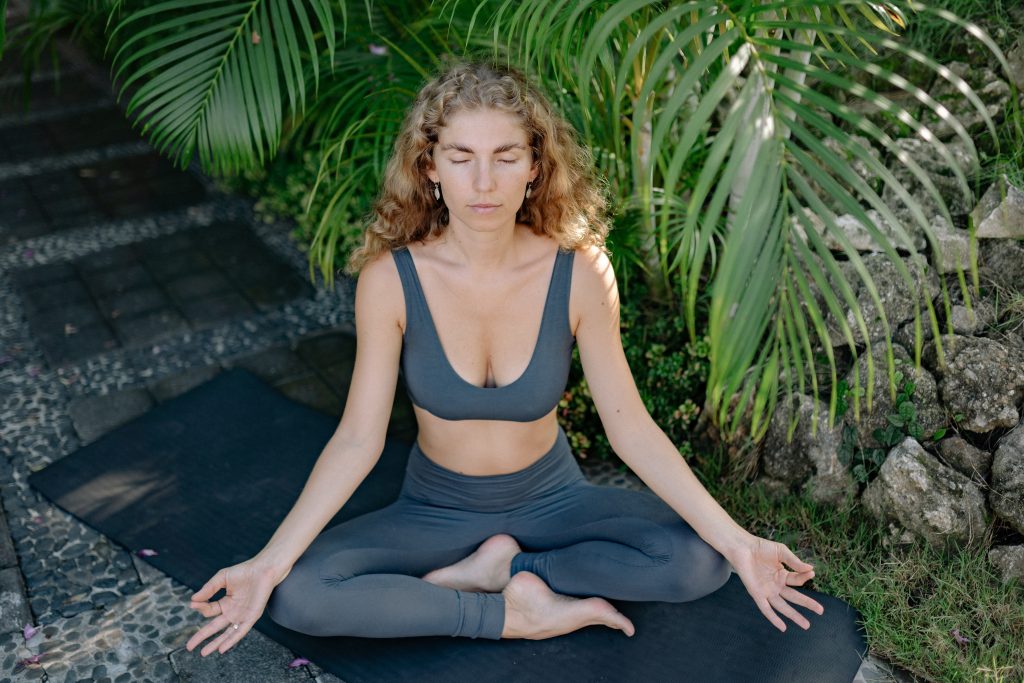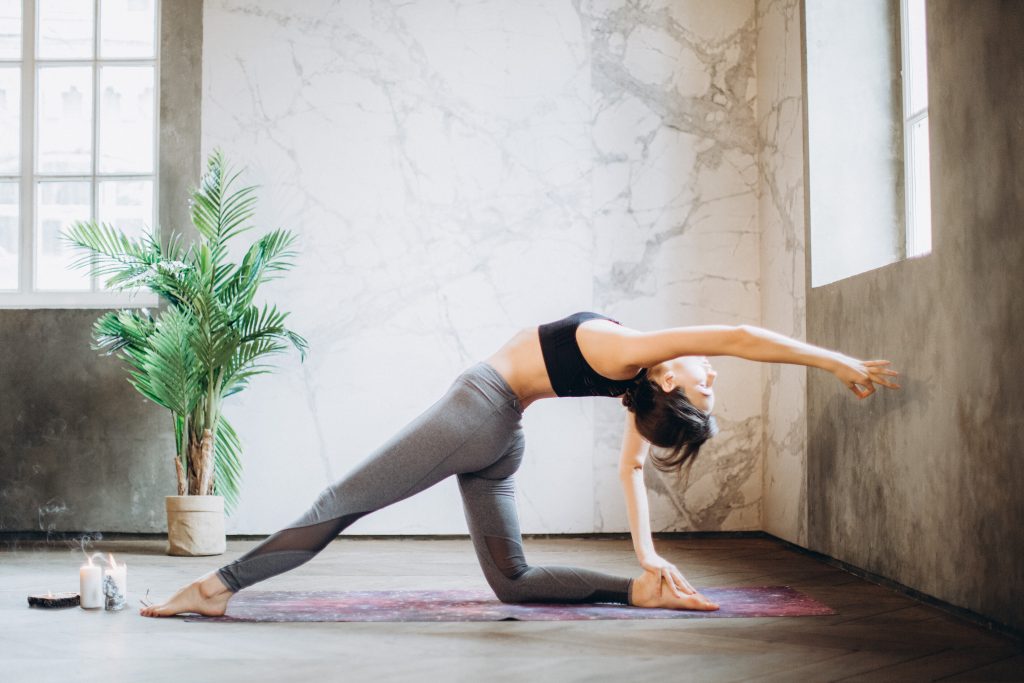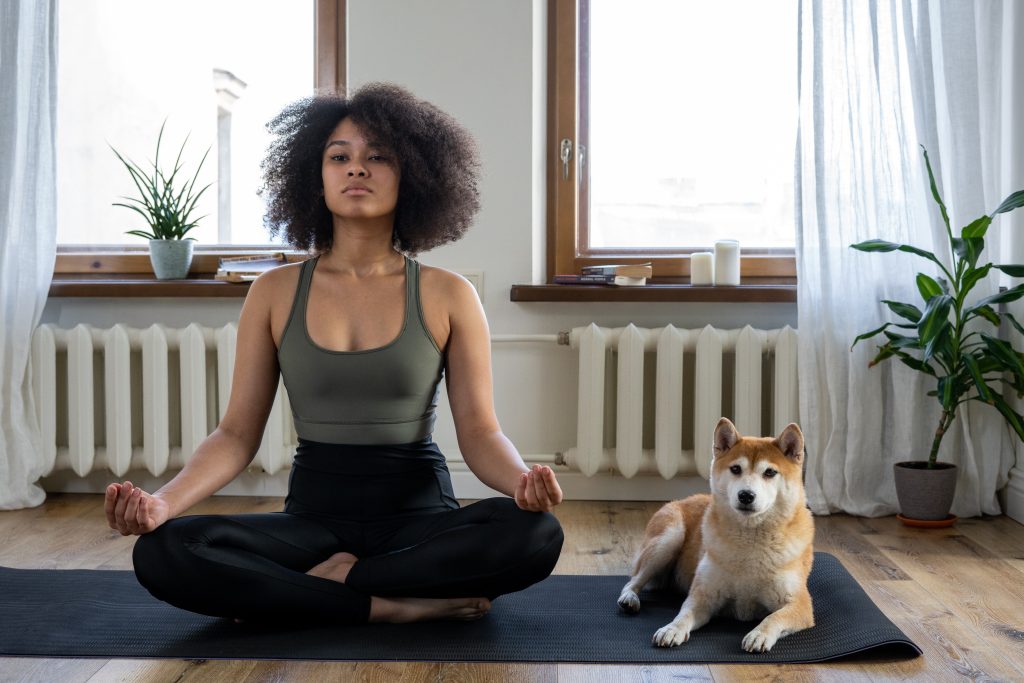As you are contorting into difficult poses that require you to stretch your flexibility, or you try to hold poses that need you to use muscles you didn’t even know you had to hold yourself in position, it becomes clear that yoga is a very physical practice.
But if you are just getting into the position or working on your flow and not connecting the movement with the breath, then you aren’t really doing yoga. You may be stretching, doing calisthenics, or doing a flow routine that is great for your body. But without the breath, it just isn’t yoga.
Conscious breathing is one of the essential and fundamental aspects of yoga. Breathing creates a deep mind-body connection that enables you to take control of your body and work more deeply into postures for greater benefit. It also helps you calm and clear the mind in a kind of “meditation in motion”, which helps rewire your brain in positive ways and promotes a better understanding of self.
In today’s article, we are going to go through why breathing is such an important part of yoga, as well as some of the essential breathing techniques that you should know to get the most out of your yoga practice.
Breathe and Yogic Philosophy
From a philosophical point of view, breathing is one of the eight limbs of the Patanjali philosophy. Called pranayama in the philosophy, yogis believe that the breath carries our life force, bringing vital energy in and expelling what is no longer needed. Taking control of the breath allows you to take control of your life force.
These ideas are reflected in the experiences of yoga practitioners who generally agree that the breathwork that they practice during yoga helps them feel more calm and grounded, both on the mat and in the rest of their lives. They are able to get deeper into their physical practice while on the mat, and they feel more able to deal with stress in the rest of their lives.
There is scientific evidence that helps explain why this might be.
It is all about the autonomic nervous system, which is connected to important physical processes in the body including digestion, respiration, heart rate, immune function, and sexual arousal. The system has two branches: the sympathetic and parasympathetic systems.
The sympathetic nervous system is our fight or flight system, which basically gives us the energy we need to deal with a situation now. But in doing so, it does things like decreasing blood flow to our digestive system and increasing blood flow to our heart. This is great when you need the energy to run from a predator. But when the response continues for weeks at a time when we are responding to things like stressful work deadlines, it can lead to serious health problems.
The parasympathetic nervous system is our rest and digest system, which is what allows us to recover from periods of fight or flight. When this system is active it does things like promote digestion and put our body into recovery mode.
Controlling our breathing, like we do in yoga but also in other practices, helps to activate the parasympathetic system to keep us calm and help us heal. It also helps us think, as our mind shifts into a more reflective mode and lets us make smart decisions rather than being driven by our emotions.

Benefits of Yogic Breathing
While we have already highlighted some of the benefits of yogic breathing while discussing the autonomic nervous system, let’s look at some of the other benefits that yogis report experiencing, which stem from this control of your nervous system and autonomic responses.
Stress Reduction
There is quite a bit of research out there on how meditation changes the brain, literally rewiring it to make us less stressed and more resilient. Yoga, when done properly with connected breathing, is a type of meditation in motion that has the same benefits of reducing stress hormones in a person, both during practice and beyond.
Improved Brain Function
As well as reducing hormones like cortisol, regular breathing techniques improve oxygen levels in the brain overall, especially in the prefrontal cortex, which makes this part of the brain more active and efficient. This is where logic and reasoning exist, allowing us to be more focused and make better decisions.
Increased Flexibility
Many people take up yoga in the hope of increasing their flexibility, and while the physical practice alone does help with this, when you combine it with linked breathing, the gains increase exponentially. This is because, when we stretch, we aren’t actually stretching to the limit that our muscles can open. Rather, we are working to the point where our nervous system says “this feels a bit risky, let’s stop”.
A stressed-out nervous system in fight or flight mode will stop you sooner since it is highly alert for any potential dangers. A calm and relaxed system will let you go further. Every time you go further, you change where your body thinks its limits are, so over time, you can greatly increase your flexibility.
Better Digestion
There are few things worse than feeling bloated or having a stomach that is growling at you while it digests. These situations often happen when we are stressed, as our fight or flight system cuts off energy to digestion for us to use elsewhere. Switching off fight or flight and switching on rest and digest means better digestion so that we can feel more comfortable in our skin.
Improved Sleep
Rest and digest also means that we tend to sleep better, as we don’t have hormones such as cortisol flooding our system and keeping our mind whirling throughout the night. Sleep is so important. It is when our body mends, and our muscles change, taking on the extra strength and flexibility that we have trained into them and making them core. This is also when our mind does the same thing, with all the new information we have taken in throughout the day being incorporated into our core programming and becoming knowledge. This is why it is always a good idea to “sleep on it”.
Read our guide to the different types of yoga practice here.

Essential Yoga Breathing Techniques
There are actually at least a dozen different types of yogic breathing that are used at different stages in the practice. Some are used when you are in motion and should be coordinated with what you are doing with your body. Others are used as a specific activity at the beginning or end of your practice. We will look at a few of the most used breathing techniques below.
Natural Breathing
Natural breathing is when you allow yourself to breathe naturally, in whatever way feels comfortable at this moment, but you pay attention and develop an awareness of what you are doing. Noticing things like how shallow or deep your breath is, whether it is coming from your chest or your abdomen, and even the temperature of your breath can tell you a lot about what is going on with your mind and body.
You’ll often be asked to spend a minute or so breathing naturally at the very start of your yoga, checking in with yourself before taking active control of your breath.
Abdominal Breathing
Abdominal breathing is when you expand your breath, trying to fill your entire diaphragm when breathing in, and then trying to expel all the air out completely. You will often rest one hand on your heart and one hand on your diaphragm to observe what is going on.
This is usually the first type of controlled breathing that you will do at the start of a yoga practice, and it may also be the breathing that you choose to do while in Savasana.
Ujjayi Breathing
This is the type of breathing used during movement in many yoga practices, especially active practices such as Ashtanga and Vinyasa yoga. You can identify it because it is quite audible. However, when done properly, while it should be audible to you, it shouldn’t really be audible to the person on the next mat.
It basically involves breathing in and out through your nose while trying to close your throat. This allows you to slow down your breathing quite significantly and helps warm up the breath as it passes in and out of your body.
Cooling Breath
Cooling breath is often used to release tension, and you might be asked to do it at a point in your practice when you are likely to have become tense, such as after headstand or shoulder stand when many people have a tendency to clench their jaw. It is also often done just before coming out of Savasana.
There are a variety of ways to do it, but generally, you will breathe in through your nose and out through your mouth. Often you will open your mouth and stick out your tongue as you force the breath out. You can also close your teeth and open your lips, and then exhale through your teeth.
Anulom Vilom
This is also known as alternative nostril breathing and it is often done as a separate practice after the physical part of the yoga practice is done. It is effective because it actually lets more oxygen into the body, which lowers stress levels and stimulates the brain. It can also help you work through any blockages.
Use your right hand and hold it in an upside-down V above your nose. You will use your index finger to close your left nostril and your thumb to close your right nostril. You will always start by breathing in through your left nostril and then breathing out through your right nostril. Next, you breathe in through your right nostril and out through your left. Apply pressure with your finger to close the nostril that you aren’t using.
Kabalabhati Breathing
This type of breathing is also known as Breath of Fire, and it is excellent for warming up the body and bringing in energy. It is great to do as part of a morning yoga practice but isn’t generally recommended for evening yoga practices.
You start with a few deep breaths, and then you will want to exhale quickly in short succession with short, sharp exhales. You achieve this by sharply contracting the lower abdomen so that it pushes a little bit of air out of your nose. As your lower stomach jumps forward again, you will naturally inhale a little, so you have more air to push out during your next quick exhale.
You would normally do 20 short, sharp exhales, and then a few deep inhales and exhales to restore your lung capacity before repeating the practice.
Bhramari Breathing
Bhramari is that final “hum” breath that you often hear at the end of the practice right before you complete your Namaste. While it might feel like a chant, it is actually designed to release stress and anxiety, and activate your body in positive ways.
Basically, breathe in through your nose deeply, and then as you exhale make a humming “mmmm” noise. Doing this will restrict your breathing, so the exhale will take longer than the inhale. The exhale should be relaxed and smooth and should never feel like a strain.
Once you are comfortable with the breath, you can block your ears with your hands or finger, elbows pointing outwards, on the exhale. This sends the vibration of the noise inside your body and makes it more effective. With practice, you can also make the humming noise on the inhale, but it is quite challenging.

FAQs
Why is breath important in yoga?
Breathing helps create a connection between the mind and body for a deeper yoga practice, and also acts as a form of meditation in motion that actives the parasympathetic nervous system which helps us remain calm and have better rest and recovery.
What is the basic philosophy of yoga?
Yoga is based on a complex philosophy with many pillars to engage with, but overall the goal is to maintain a more engaged state of awareness, which is called Moksha or Samadhi. This is an awareness of yourself in terms of both your body and your mind.
You can read all of our yoga articles here.
The Verdict
Breathing is an essential part of practicing yoga. If you aren’t doing the breathing, you aren’t really doing yoga. It was what differentiates yoga from other physical practices and makes it also a meditative and spiritual practice.
While there are a variety of different breathing techniques, they are not hard to learn. What is hard is keeping focussed on your breath throughout your yoga practice and not letting your mind wander or forget your breathing as you get into difficult positions.
It is important to constantly remind yourself to focus on your breathing. Don’t feel discouraged if you have to remind yourself a lot! This is completely normal, even for advanced yogis depending on the day. It is a similar challenge to meditation while you try not to let your mind get distracted. No one sits there with no thoughts creeping in, but those with a meditation practice know how to put those thoughts to one side. It is the same with yoga, those with a practice know how to return to their breathing when they get distracted.

